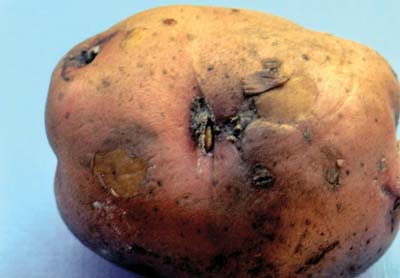
Potato tuberworm, Phthorimaea operculella, pupa in potato.
(University of Florida)
The potato tuberworm feeds primarily on potato but other vegetable crops that may be infested include eggplant, pepper, and tomato. Some solanaceous weeds such as bittersweet, nightshade, groundcherry, horsenettle, and jimsonweed serve as alternate hosts. Damage caused by the potato tuberworm include leaf mining, stem mining, and tunneling of tubers. Populations of potato tuberworm can be determined in the field using sampling techniques such as pheromone traps, sticky traps, funnel traps, and water traps. Insecticides are often applied to the foliage to control tuberworm populations, and insecticide resistance may be a problem. Insecticides also interfere with natural enemies and should be taken into account before they are applied. Cultural control practices include crop rotation, sanitation, destruction of crop residue, deep planting of potato seed, and host plant resistance. Mass trapping using sex pheromones may also be used to reduce damage in the field.
Images
To save the Web-optimized images shown below to your hard drive:
|
Click to access Display and Print quality images. |